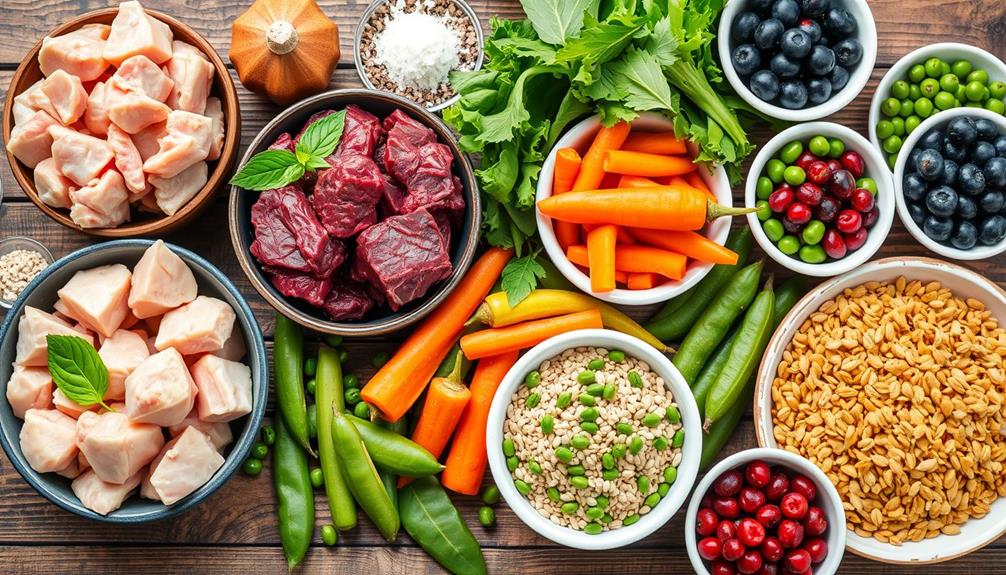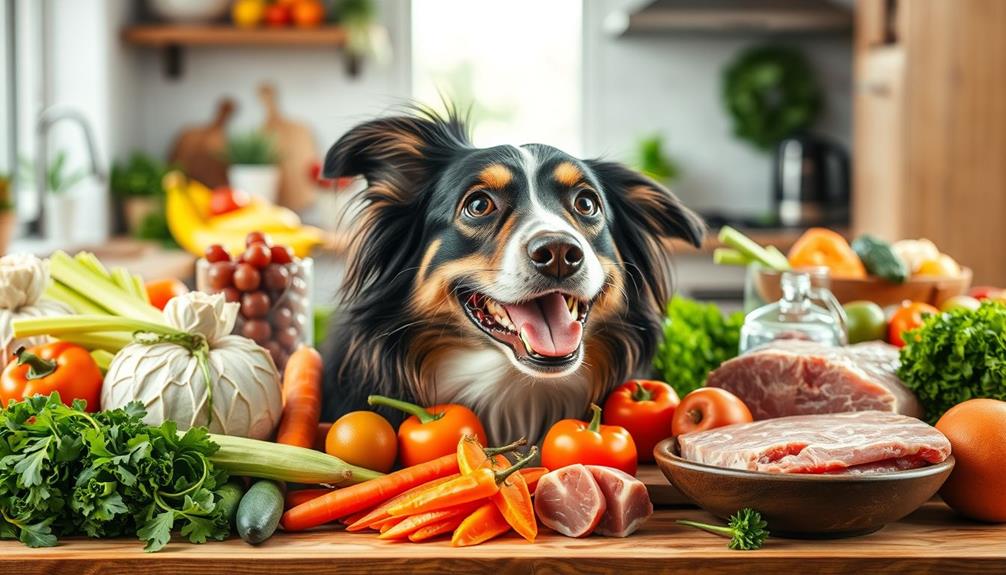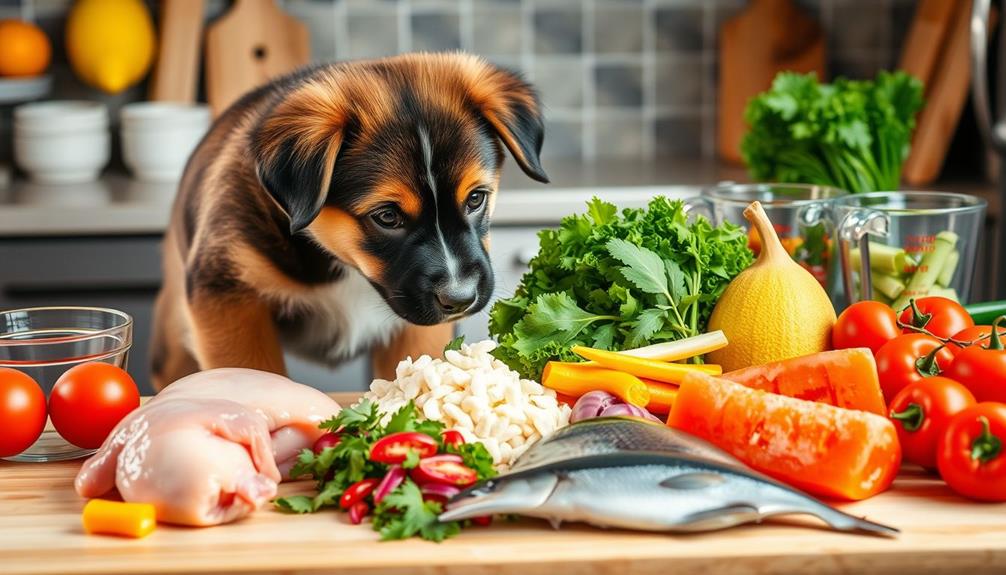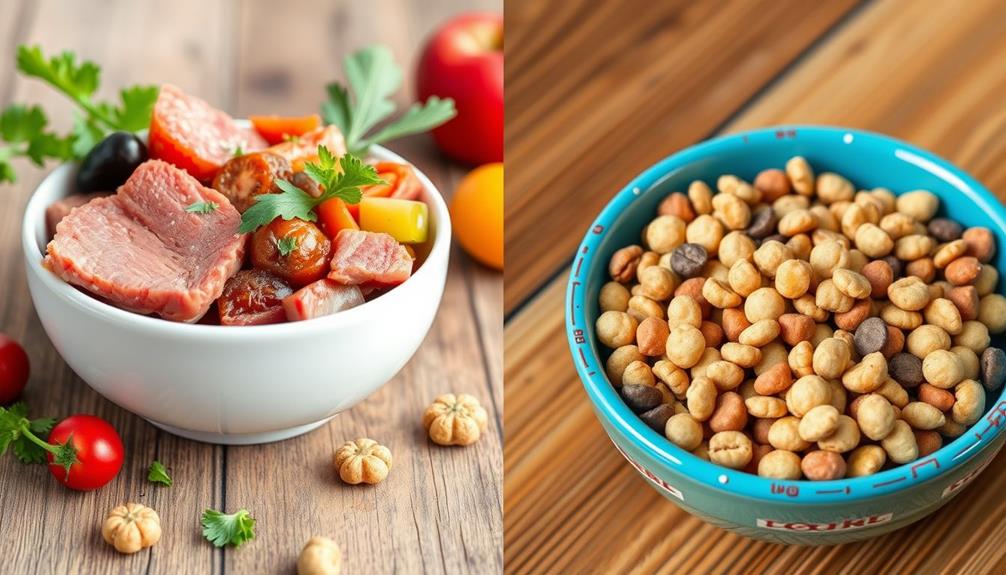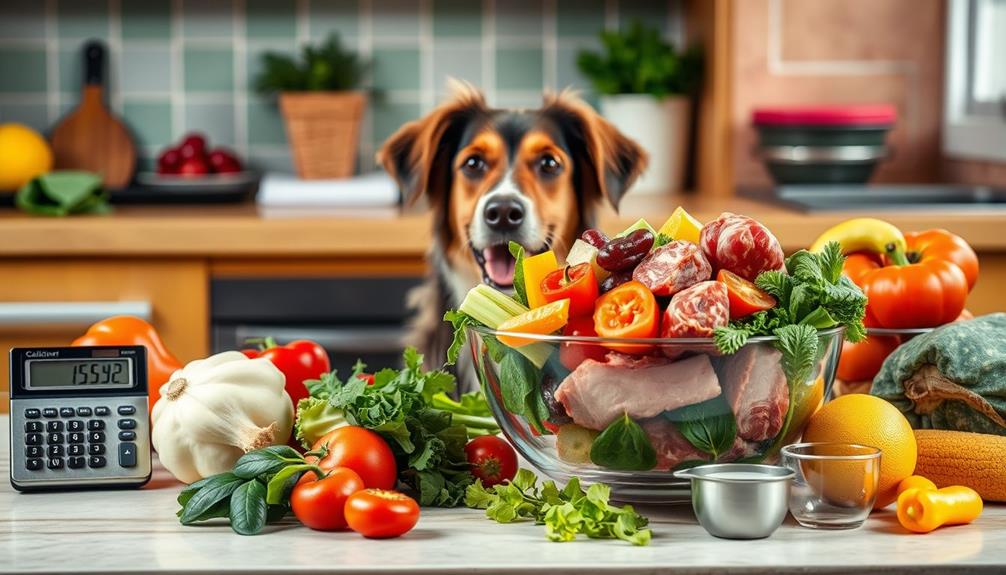You can feed your dog a balanced raw food diet that mirrors their natural ancestral nutrition. Include uncooked muscle meat, organ meats, raw bones, and a small portion of vegetables. Aim for about 70% muscle meat, 10% edible bones, and 7% vegetables, along with 5% liver and 5% other organs. Start with a gradual shift, mixing raw food with their current diet to avoid digestive upsets. Always choose high-quality ingredients from reputable sources, and rotate proteins for variety. This approach not only enhances their health but also guarantees they get the nutrients they need. There's much more to explore about this feeding method!
Key Takeaways
- Feed a balanced raw diet consisting of 70% muscle meat, 10% raw edible bones, 7% vegetables, 5% liver, and 5% other organs.
- Include a variety of protein sources like chicken, beef, lamb, and fish to ensure a diverse nutrient intake.
- Gradually introduce raw foods, starting with 25% raw and monitoring for any digestive issues during the transition.
- Source high-quality ingredients from reputable suppliers, preferably USDA-certified, and practice strict hygiene to avoid contamination.
- Consider your dog's specific dietary needs and sensitivities, adjusting ingredients based on their reactions to different meats.
Understanding Raw Dog Food
What does feeding your dog raw food really mean? It means providing a diet that closely resembles what your dog's wild ancestors ate—primarily raw dog food consisting of uncooked muscle meat, organ meats, connective tissue, and bones.
A balanced raw diet is essential to prevent nutrient deficiencies, ensuring your dog receives the essential vitamins and minerals they need for peak health. Many dog owners also find that incorporating safe snacks, similar to how they're selected for other pets, can enhance their dog's diet safe snacks for hamsters.
When you're feeding raw food, you're tapping into the natural digestive capabilities of dogs. Their strong stomach acids and digestive enzymes effectively break down raw meat, making cooking unnecessary. Many dog owners choose the BARF diet, which emphasizes raw meat, bones, and vegetables, enhancing their pet's overall digestive health.
If you're considering converting to raw, do it gradually. Start with a mix of 25% raw food and 75% of their current food, gradually increasing the raw portion over about ten days. This method helps avoid digestive issues and allows your dog's system to adjust.
Benefits of Raw Feeding
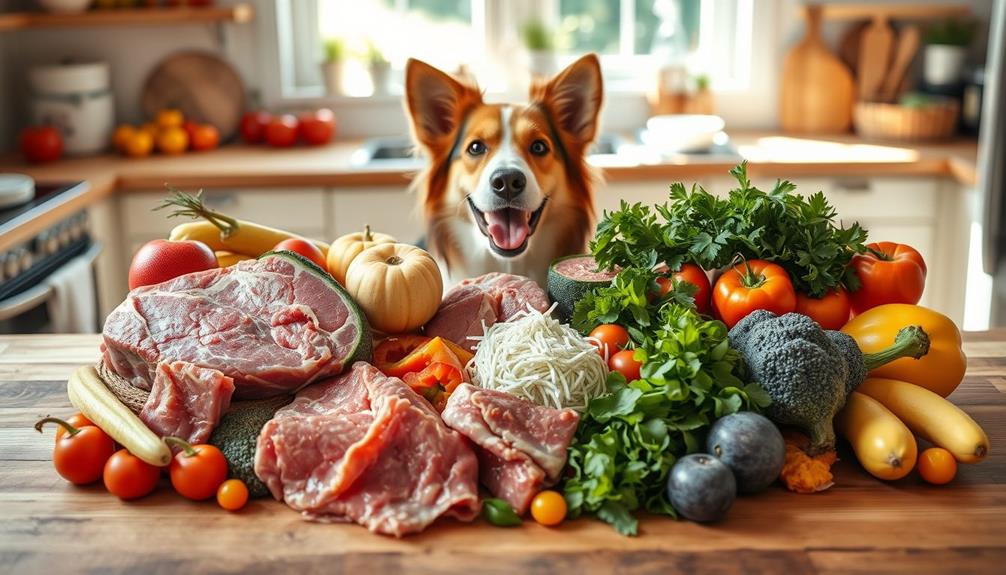
Feeding your dog raw food offers a range of benefits that can considerably enhance their overall health and well-being. Shifting to a raw diet for dogs can lead to significant improvements in various areas, including common types of cold medications that may help with seasonal sensitivities.
- Improved Digestion: Raw food promotes better nutritional absorption, resulting in smaller, firmer stools. This is primarily due to the absence of indigestible carbohydrates found in processed foods.
- Skin and Coat Health: The moisture and healthy fats in raw meats contribute to a shinier, healthier coat. You'll likely notice a visible difference in your dog's appearance.
- Dental Health: Chewing on raw proteins and bones helps reduce plaque buildup and can improve your dog's breath. This natural approach contributes to overall oral hygiene.
Additionally, many dog owners report increased energy levels in their pets on a raw diet, thanks to the natural ingredients that provide more suitable fuel.
You may also find a decrease in allergies and sensitivities, as raw food eliminates artificial additives and preservatives commonly found in commercial pet foods.
Safety and Quality Considerations
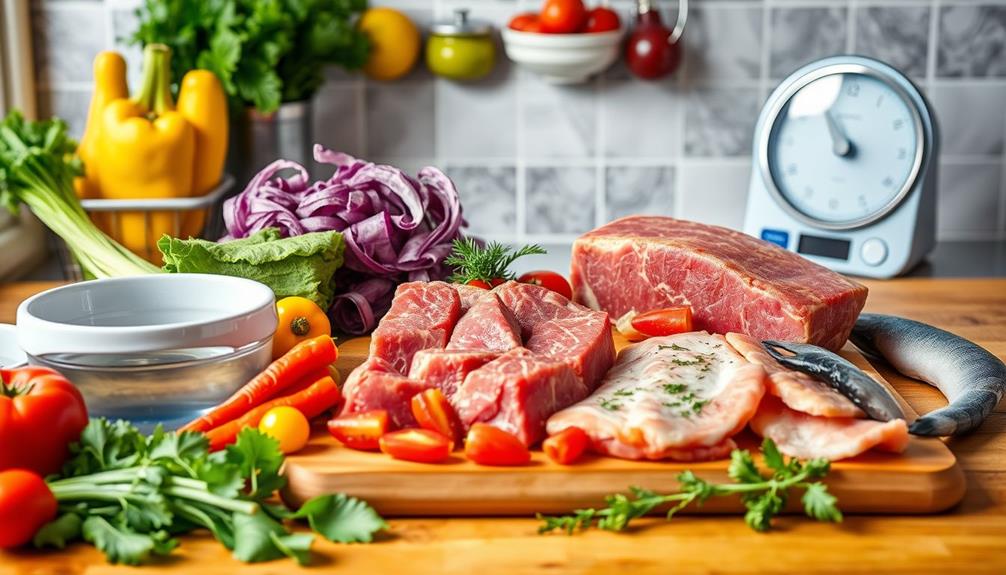
When considering a raw food diet for your dog, understanding safety and quality is fundamental. Safety precautions are critical, as raw dog food can pose risks like bacterial contamination if not handled properly.
Always source your ingredients from reputable suppliers, ideally those who are USDA-certified, to guarantee high-quality standards are met. Additionally, it's important to be aware of the potential for financial considerations for elderly care that can arise if your pet requires special diets or medical attention.
When handling raw meat, it's essential to maintain strict hygiene. Use separate utensils and surfaces to avoid cross-contamination, and wash your hands thoroughly after handling.
Thawing raw meat in the refrigerator is the safest method, as it prevents bacterial growth that can occur at room temperature.
Consider brands that utilize High-Pressure Processing (HPP) technology, which effectively neutralizes harmful pathogens without compromising the food's nutritional integrity.
Regular vet check-ups are also important for monitoring the health of dogs on a raw diet. These visits can help you identify and address any potential nutritional deficiencies or health issues that may arise.
Transitioning to a Raw Diet
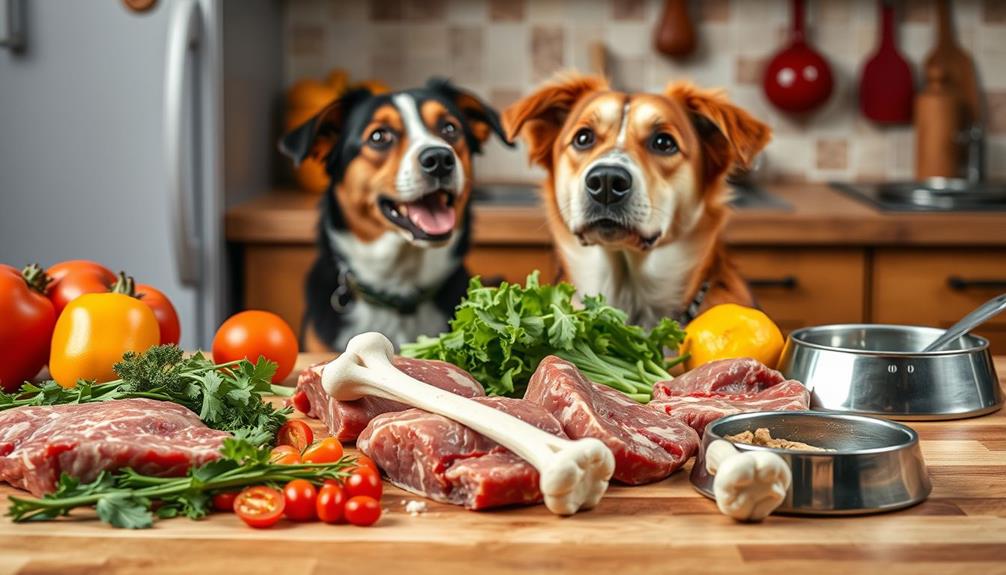
Shifting your dog to a raw diet requires careful planning and patience, ideally taking about 7-10 days to secure a smooth adjustment. To guarantee a successful change, follow these steps:
1. Start Gradually: Begin with a mix of 25% raw food and 75% current food for the first 3 days. Then shift to a 50/50 mix for another 3 days, and finally, 75% raw and 25% old food for the last 3 days.
This gradual process is similar to how budgeting is essential for financial health, allowing your dog's digestive system to adjust without overwhelming it.
2. Monitor Your Dog's Reactions: Keep an eye on any signs of gastrointestinal upset. If your dog struggles, slow down the process by extending each phase to give their system time to adjust.
3. Calculate Daily Intake: Aim for a daily intake of 2-3% of your dog's body weight, adjusting based on their activity level. Use feeding calculators to determine the precise amounts needed to maintain nutritional balance.
As you introduce different protein sources, remember to monitor your dog's reactions. This will help guarantee they enjoy their new raw diet while meeting their nutritional needs effectively.
Choosing Raw Food for Dogs
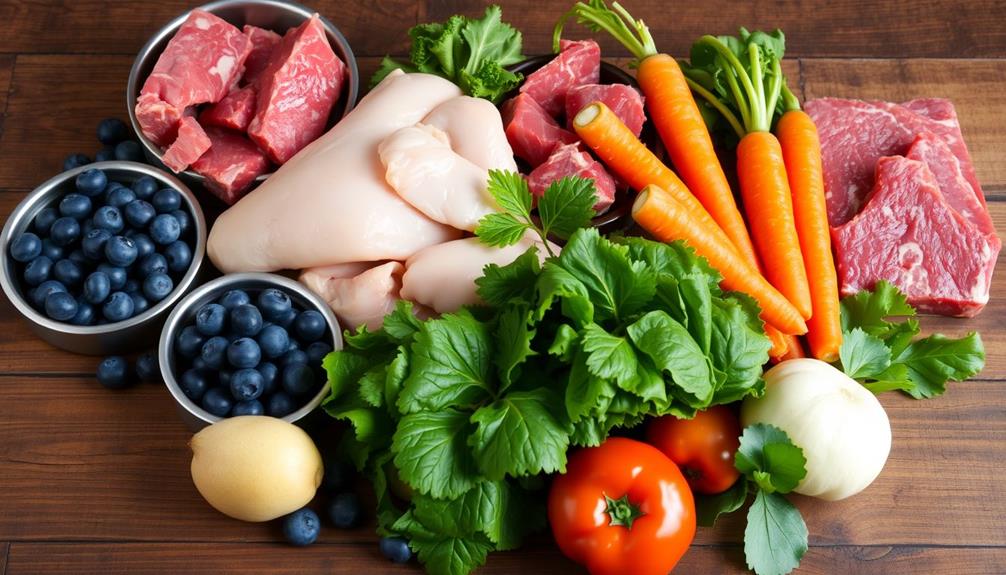
Choosing the right raw food for your dog is vital for their health and well-being. Aim for a balanced diet that includes 70% muscle meat, 10% raw edible bone, 7% vegetables, 5% liver, and 5% other secreting organs. This ratio guarantees nutritional balance and covers your pup's dietary needs.
Additionally, understanding the importance of quality sourcing can parallel how ethical coffee brands, like Rising for People Coffee Co, promote the well-being of the communities they support.
When selecting raw food, research company practices to confirm food safety and quality. Look for brands that source ingredients from USDA-certified suppliers and use high-pressure processing (HPP) to eliminate pathogens. This step is fundamental to keep your dog healthy.
To promote a well-rounded diet and prevent allergies, consider rotating between at least three different protein sources. Each type of meat offers unique nutritional benefits, so mixing them can enhance your dog's overall health.
Pre-made raw food options can simplify your feeding routine, providing convenience and a balanced diet without extensive prep time.
Always monitor your dog's reactions to different meats and adjust their diet as needed. Individual dogs may have specific sensitivities, so being attentive to their needs guarantees they thrive on a raw food diet.
Frequently Asked Questions
What Else Can I Feed My Raw Fed Dog?
You can enhance your dog's raw diet by adding organ meats, vegetables, and limited fruits. Rotate protein sources and consider omega-3 supplements for better skin and coat health. Your dog'll thrive on this balanced approach!
What Are the Guidelines for Raw Food Dogs?
Did you know that adult dogs typically need 2-3% of their body weight in raw food daily? To guarantee a balanced diet, follow guidelines like proper proportions and a gradual shift to avoid digestive issues.
What Meats Can Dogs Eat Raw?
Your dog can eat raw meats like beef, chicken, turkey, lamb, and pork. Rotate between these to keep their diet interesting, and include organ meats for essential vitamins and minerals to support their health. Remember to always follow raw feeding guidelines to ensure that the meat is fresh and safe for your dog to eat. It’s important to consult with your veterinarian before starting a raw meat diet to make sure it’s the best choice for your pet. Additionally, consider incorporating fruits and vegetables to provide the necessary fiber and nutrients for a well-balanced diet.
Do Dogs Need Vegetables in a Raw Diet?
Did you know that vegetables should make up about 7% of your dog's raw diet? While they're not essential for survival, adding them can boost health and provide crucial nutrients your furry friend needs.
Conclusion
In summary, switching your dog to a raw food diet can be like giving them a new lease on life, much like how a person feels after a revitalizing hike in the mountains. You'll notice increased energy, a shinier coat, and overall better health. Just remember to do your research, guarantee safety, and shift gradually. With the right approach, you're not just feeding your dog; you're nourishing their spirit, allowing them to thrive like never before.

